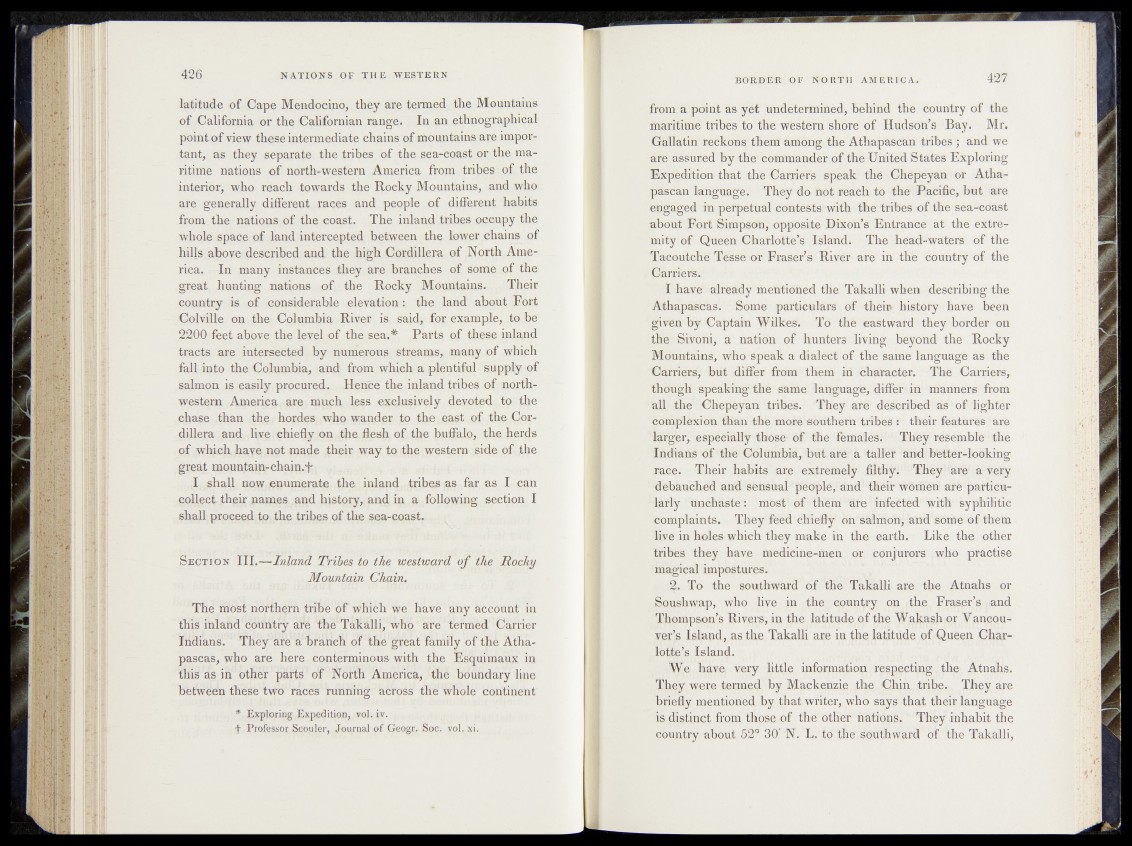
latitude of Cape Mendocino, they are termed the Mountains
of California or the Californian range. In an ethnographical
point of view these intermediate chains of mountains are important,
as they separate the tribes of the. sea-coast or the maritime
nations of north-western America from tribes of. the
interior,- who reach towards the Rocky Mountains, and who
are generally different races and people of different habits
from the nations of the coast. The inland tribes occupy the
whole space of land intercepted between the lower chains of
hills above described and the high Cordillera of North America.
In many instances they are branches ef some of the
great hunting nations of the Rocky Mountains. .Their
country is of considerable eleyation: the land about Fort
Colville on the Columbia River is said, for example, to be
2200 feet above the level of the sea.# Parts of these inland
tracts are intersected by numerous! streams, many of which
fell into the Columbia, and from which a plentiful - supply of
salmon is easily procured. Hence the inland tribes of northwestern
America are much less exclusively deyoted to
chase than the hordes who wander to the, east the?.Qopdillera
and live chiefly on the flesh of. the buffalo, the hec-fjs
of which liaye not made their way to the western side of the
great mountain-chain.+
I shall now enumerate the inland tribes as far as I can
collect jtheir jnames and history, and in aa following ^section I
shall proceed to the tribes of the sea-coast.
S ection II I.—Inland Tribes to the westward o f the Rocky
Mountajf. Chain. |
The most northern tribe of which we have any account in
this inland'country are the Takalli, who are termed Carrier
Indians. They are a branch of the great family of the Atha-
pascas, who are here conterminous with the Esquimaux in
this as in other parts \ oi North America, thè boundary line
between these two races running across the Whole continent
* Exploring Expedition* yol. iv.
f Professor Scouler, Journal pf Geogr, Soc. vol,.xi.
from a point as yet undetermined, behind the country of the
maritime'tribes to the westërri ’éfióré of Hudson’s Bay. Mr.
Gallatin reckons them among the Athapascan tribes ; and we
arë assured by the commander of the United States Exploring
Expedition that the Carriers speak the Chepeyan or Athapascan
*language4.’' They do not reach to the Pacific, but are
engaged in perpetual contests*with the trihes of the sea-coast
about Fort Simpson, opposite Dixon’s Entrance at the extremity
of Queen Charlotte’s Island. The head-waters of the
TacoutchëTeSse o r Fraser’s River are in the country of the
• Carriers; ■
I have already mentioned the Takalli when describing the
Athapascas. Some particulars of them history have been
given by Captain Wilkes. To thè eastward they border on
the Sivoni, a nation of hunters living beyond the Rocky
Mountains, who speak a diale'ëtjlof the same language as the
Carriers, but differ from them in character. The Carriers,
thöiigh speaking the same language, differ j in manners from
all the Chepeyan tribe#.-1 They; are described a# ■ of fighter
complexion than the tAore Coutheth tr ib e s th e ir featured are
'ÏÖfgbri especially those of the females.5 They rëêemblè ‘ tfeé
Indians Of the Columbia, biff are a taller tÈnd^bfettér-loóking
race. Their habits are extremely fiithyi: -’They^fe^ a very
debauched and sensual-people^ and'thëit WOitoetf are particularly
u n c h a s temóst* ©f!*thëtó',#fe-)''ItÈfeë8édfc;JWJffi’ syphilitic
complaints. They* feed chiefly on salmoffj and some of them
live in holes which they make in the earth. Like the other
tribes they have medicine-men or. ponjurors who practise
magical impostures.
To the southward of the Takalli are the Atnahs or
Soushwap, who live in the country on j the Fraser’^-? and
Thompson’s Rivers, in the latitude of the ^aj^ash or Vanoou^
ver’s Island, as the Takalli are in the latitude of Queen Charlotte’s
Island.
We have very little information respecting. the Atnahs.
They were termed by Mackenzie 4fre ,Chin tribe. They are
briefly mentioned by that writer, who says that their language
is distinct from those of the Other natións. | They inhabit the
country about 52° 30' N. L. to the southward of the Takalli,